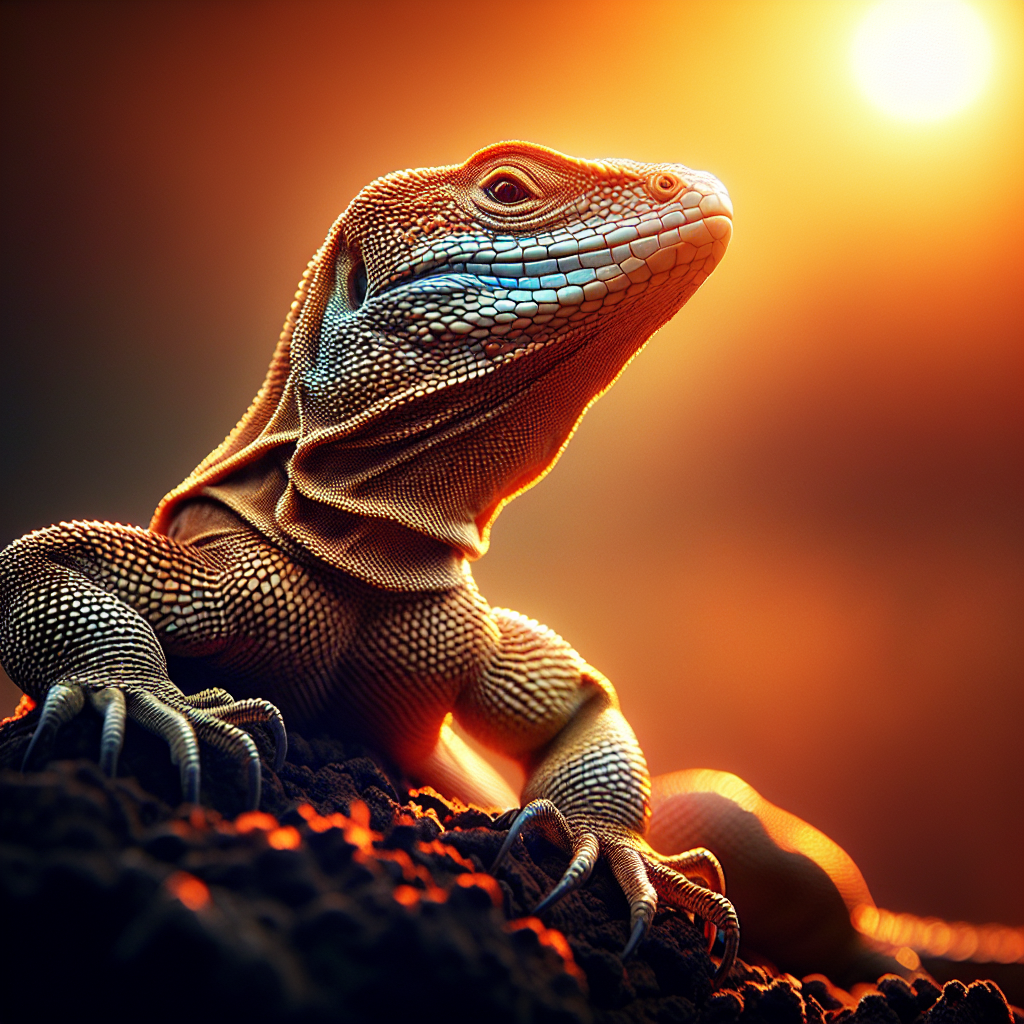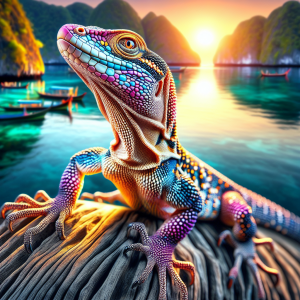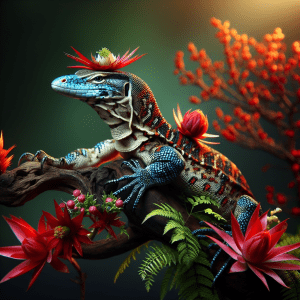Introduction: Lizard Diversity in Indonesia
Have you ever stopped to marvel at the incredible diversity of lizards in Indonesia? These fascinating creatures are more than just scaly reptiles—they play a crucial role in the intricate web of life in this tropical paradise.
From the vibrant forests of Sumatra to the remote islands of Papua, Indonesian lizards have adapted to a stunning array of environments. Picture yourself trekking through lush jungles, catching glimpses of colorful geckos darting among the leaves.
One intriguing fact about lizard diversity in Indonesia is that this archipelago nation is home to over 300 species of lizards, each with its own unique characteristics and behaviors. Can you imagine encountering a Komodo dragon, the largest lizard on Earth, in its natural habitat?
As an expert in lizard biology, I’ve had the privilege of studying these remarkable creatures up close. I’ve witnessed firsthand how their presence shapes the ecosystems they inhabit, from regulating insect populations to serving as prey for larger predators.
But with habitat destruction and climate change threatening their survival, the future of Indonesian lizards hangs in the balance. How can we ensure that future generations will still have the opportunity to witness the beauty and diversity of these captivating creatures?
Join me on a journey through the enchanting world of lizard diversity in Indonesia, where every encounter with these ancient reptiles reveals a new chapter in the ongoing story of life on Earth. Let’s explore, learn, and celebrate the remarkable lizards that call Indonesia home.
Importance of Lizards in Indonesian Ecosystem
Lizard diversity in Indonesia is truly fascinating. Did you know that Indonesia is home to over 300 species of lizards? That’s mind-blowing! These creatures play a vital role in the ecosystem, keeping insect populations in check and serving as indicators of environmental health.
One of the most unique lizard species found in Indonesia is the Komodo dragon, the largest lizard on Earth. Picture encountering this giant reptile in the wild – an unforgettable experience, right? The diverse habitats in Indonesia, from lush rainforests to arid savannas, provide ideal conditions for a wide variety of lizard species to thrive.
However, the increasing threats to lizard diversity, such as habitat destruction and illegal wildlife trade, pose significant challenges. Conservation efforts are crucial to protect these incredible creatures for future generations to enjoy. Have you ever thought about how you can contribute to lizard conservation in your own way?
Exploring the rich cultural significance of lizards in Indonesian folklore adds another layer of intrigue to these fascinating creatures. Imagine the stories and myths that have been passed down through generations about these mysterious reptiles. Have you ever heard any folklore about lizards in your own culture?
As we delve deeper into the world of lizard diversity in Indonesia, it becomes apparent that these remarkable creatures are not just fascinating in their own right but also essential components of a complex and interconnected ecosystem. Let’s continue our journey to uncover more about the incredible world of Indonesian lizards.
Top Unique Lizard Species in Indonesia
Ever heard of the Satanic Leaf-tailed Gecko? It’s not just a creative name – this little guy is a master of camouflage.
Indonesia is home to some of the most unique lizard species on the planet.
These creatures have evolved remarkable adaptations to survive in their diverse habitats.
Imagine stumbling upon a frilled lizard, its neck expanding like a colorful umbrella.
The vibrant colors of the Green Tree Monitor are a sight to behold in the wild.
One of the challenges facing Indonesian lizards is habitat destruction due to deforestation.
Conservation efforts play a crucial role in protecting these fascinating creatures for future generations.
Have you ever wondered how these lizards communicate with each other in the wild?
Learning more about Indonesian lizard diversity opens up a world of wonder and discovery.
Next time you visit Indonesia, keep an eye out for these incredible creatures in their natural habitats.
Distribution and Habitats of Indonesian Lizards
Have you ever wondered about the diverse habitats where Indonesian lizards thrive? From lush rainforests to arid savannas, these fascinating creatures have adapted to a wide range of environments. Picture this: a vibrant green gecko blending seamlessly into the dense foliage, or a colorful skink basking in the sun on a rocky outcrop. These unique adaptations make Indonesian lizards a captivating subject of study.
One interesting fact about Indonesian lizards is their remarkable ability to camouflage themselves in their surroundings. Have you ever tried to spot a well-camouflaged lizard in the wild? It’s like searching for a hidden treasure! Their camouflage not only helps them evade predators but also allows them to ambush unsuspecting prey.
Exploring the distribution and habitats of Indonesian lizards can lead to a deeper appreciation for the rich biodiversity of this tropical paradise. It’s truly amazing how these creatures have carved out their niche in the complex tapestry of Indonesian ecosystems. So, next time you venture into the wilds of Indonesia, keep an eye out for these elusive reptilian wonders – you never know what fascinating encounters await you!
Threats to Lizard Diversity in Indonesia
Are you ready to dive into the fascinating world of lizard diversity in Indonesia? Let’s explore!
Do you know that Indonesia is home to over 300 species of lizards? These incredible creatures play a vital role in the ecosystem.
Now, here’s an interesting fact: the Komodo dragon, the largest lizard in the world, can only be found in Indonesia. It’s truly a unique species!
As we delve deeper into the distribution and habitats of Indonesian lizards, you’ll discover the diverse landscapes they call home.
Imagine stumbling upon a colorful Tokay gecko or a vibrant flying lizard during your exploration. The beauty of Indonesian lizard species is truly mesmerizing.
However, there are challenges to the conservation of these remarkable creatures. How can we protect their habitats and ensure their survival?
Conservation efforts are crucial in safeguarding the rich biodiversity of Indonesian lizards. Every small step makes a big difference in preserving these species.
As you embark on your lizard watching adventures in Indonesia, remember to respect their natural habitats and observe them from a distance.
Let’s ponder this question: How can we raise awareness about the importance of preserving lizard diversity in Indonesia for future generations?
By learning more about these fascinating creatures and their significance, we can appreciate the intricate balance of nature in Indonesia.
Conservation Efforts to Protect Indonesian Lizards
Conservation efforts to protect Indonesian lizards are crucial for preserving the rich biodiversity of this tropical paradise. Did you know that Indonesia is home to more than 350 species of lizards, each with its own unique characteristics and behaviors? From the vibrant colored chameleons to the elusive Komodo dragons, Indonesian lizards play a vital role in maintaining the ecological balance of the region.
One practical tip for responsible lizard watching in Indonesia is to always respect their natural habitats and avoid disturbing their environments. By observing these fascinating creatures from a distance, you can enjoy their beauty without causing them harm. Have you ever wondered how researchers track and study the diverse lizard populations in Indonesia? The advancements in technology have allowed scientists to monitor lizard movements and behaviors more accurately, providing valuable insights into their conservation needs.
As we delve deeper into the world of Indonesian lizards, it becomes evident that our actions have a direct impact on their survival. By raising awareness about the importance of lizard diversity and supporting conservation efforts, we can ensure that future generations will continue to marvel at the wonders of these incredible creatures. Let’s join hands in protecting the enchanting world of Indonesian lizards for a sustainable future.
Role of Lizards in Indonesian Culture and Folklore
Have you ever wondered about the role of lizards in Indonesian culture and folklore? It’s a fascinating topic that sheds light on the deep connection between these reptiles and the local people. In Indonesia, lizards have long been intertwined with myths and legends, often symbolizing different traits and characteristics.
One interesting fact is that in some Indonesian folklore, lizards are believed to bring good luck and prosperity to households. People may keep small statues or images of lizards in their homes as a symbol of protection and fortune. On the other hand, there are also stories where lizards are seen as tricksters or symbols of mischief, adding an element of mystery to their cultural significance.
Exploring the stories and beliefs surrounding lizards in Indonesian culture can provide valuable insights into the traditional beliefs and values of the local communities. It’s a way to delve into the rich tapestry of Indonesian heritage and understand how these ancient tales continue to shape the cultural landscape today.
So next time you spot a lizard scurrying across your path in Indonesia, take a moment to appreciate the deeper layers of meaning behind these fascinating creatures. Who knows, you might just uncover a new perspective on the world of lizards and their enduring presence in Indonesian folklore.
Research and Discoveries in Indonesian Lizard Diversity
Have you ever heard of the Komodo dragon, the largest lizard species in Indonesia and the world? These fascinating creatures, native to the Indonesian islands of Komodo, Rinca, Flores, and Gili Motang, are truly remarkable. With their massive size and unique predatory behaviors, they are a sight to behold in their natural habitat.
The Komodo dragon, also known as Varanus komodoensis, can grow up to 10 feet in length and weigh over 150 pounds, making them apex predators in their ecosystem. These ancient reptiles have a keen sense of smell and sharp teeth, allowing them to hunt and devour prey much larger than themselves.
One interesting fact about the Komodo dragon is their venomous bite. While it was previously believed that their saliva contained deadly bacteria, recent research has shown that they actually produce venom that helps to weaken and immobilize their prey. This venomous adaptation sets them apart from other lizard species and underscores their unique evolutionary history.
Despite their fearsome reputation, Komodo dragons are facing significant threats due to habitat loss, poaching, and climate change. Conservation efforts are crucial to protecting these magnificent creatures and preserving their role in the delicate balance of Indonesia’s ecosystems.
As we continue to study and learn more about the incredible diversity of lizard species in Indonesia, it’s essential to appreciate the importance of these fascinating creatures in the natural world. The Komodo dragon serves as a symbol of the rich biodiversity found in Indonesia and the urgent need to conserve and protect these remarkable reptiles for future generations to admire and learn from.
Tips for Responsible Lizard Watching in Indonesia
Imagine you’re trekking through the lush jungles of Indonesia, eyes peeled for a glimpse of a majestic lizard. You’re eager to witness the diverse array of lizard species that call this tropical paradise home. But hold on! Before you embark on your lizard-watching adventure, let’s delve into some tips for responsible lizard observation.
First things first, always maintain a respectful distance from these fascinating creatures. Remember, you’re stepping into their territory, so it’s crucial to observe from afar without disturbing their natural behavior. By keeping a safe distance, you’ll be able to admire their beauty without causing any unnecessary stress.
Another essential tip is to avoid feeding wild lizards. While it may be tempting to offer them a snack, human food can be harmful to their health and disrupt their natural diet. Let them forage for their own food as nature intended.
Additionally, be mindful of your surroundings and tread lightly to minimize your impact on the environment. Lizards play a vital role in the ecosystem, so it’s crucial to protect their habitats and avoid leaving any trace of your visit behind.
As you embark on your lizard-watching expedition, remember that these incredible creatures are an integral part of Indonesia’s rich biodiversity. By observing them responsibly, you’re not only preserving their natural habitat but also contributing to the conservation of these remarkable species for future generations to enjoy. So, go ahead and immerse yourself in the captivating world of Indonesian lizards with these tips in mind!
Conclusion: Preserving the Rich Lizard Biodiversity in Indonesia
Have you ever marveled at the incredible lizard diversity in Indonesia? It’s truly mind-blowing. Picture this: lush rainforests teeming with vibrant colors and exotic creatures. Now, let me tell you about my unforgettable adventure deep in the heart of Indonesia.
During my journey, I encountered a rare lizard species known for its dazzling blue markings. This sighting made me appreciate the sheer beauty and diversity of Indonesia’s lizard population. Did you know that Indonesia is home to over 350 species of lizards? That’s more than any other country in the world! This fascinating fact showcases the country’s rich biodiversity and the importance of conserving these incredible creatures.
But, as with any natural wonder, there are challenges to preserving this biodiversity. Illegal wildlife trade and habitat destruction pose serious threats to Indonesia’s lizard population. So, what can we do to protect these amazing creatures? One practical tip is to support local conservation efforts and raise awareness about the importance of preserving lizard diversity. Every small action can make a big difference in safeguarding these unique species for future generations to enjoy.
As we delve deeper into the world of Indonesian lizards, it’s essential to remember the broader significance of biodiversity conservation. These lizards play a crucial role in maintaining the delicate balance of the ecosystem, contributing to the overall health of our planet. So, let’s join hands in protecting Indonesia’s lizard diversity and ensure a sustainable future for all species to thrive.




